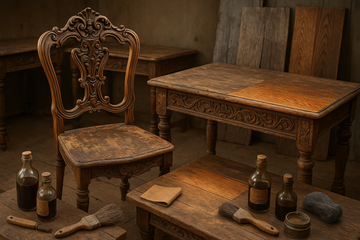Wood furniture, floors, surfaces and suites bring a prestigious yet natural, classic look to your kitchen. Unfortunately, they are more prone to the effects of winter than any other material. With the wet and cold coming around, the porous nature of wood attracts mold.
The good news is that preventing your wood from becoming moldy is easily achieved with a bit of care, attention and awareness around how mold creeps into the home. Alongside implementing regular wood cleaning techniques, there are a few things to consider to keep your wood mold-free. This will make sure you have a well presented kitchen that is, crucially, hygienic.
Household Infrastructure
One of the main causes of damp creeping within the house is having water sitting in the pipes for extended periods. This can cause the pipes to breakdown, or even naturally precipitate moisture when central heating systems are turned on. The result is a greater residual level of moisture in your house and in the air, which leads to damp issues.
The kitchen often gravitates around heat and water, so the mold problem can be particularly focused in your food preparation area. You can help prevent this by using de-humidifiers to remove moisture from the air. You could also consider large-scale alterations, such as changing to a tankless water system. This will reduce the chance and incidence rate of extra moisture.
Ventilation...
Going hand in hand with the extra moisture is making sure your house stays ventilated. The World Health Organization found that ventilation is key for air quality in your house. This includes the process of removing mold spores, which are the cause of permeating mold in your wooden surfaces.
In older houses, ventilation may not be an option due to the lack of considerations made when the property was built. You can get involved here by opening windows in your house on a regular basis, and especially if you’re cooking and preparing food (alongside showers, baths and drying clothes). You can also put fans in the house and leave doors open, though this can be counterproductive when it’s cold. The best thing to do is to pay for fan installation in key areas. For kitchens, this can take the form of HVAC systems above your cooker to remove any moisture and heat from the room.
...and Insulation
If you’ve managed to dry out your house to an acceptable level and get the air circulation at a good level, it might seem counterintuitive to suggest insulating your house. However, this to keep cold air and wet from getting from the inside in. There are many options for barrier insulation, but the main key is to create a solid barrier around your windows and doors so when they’re shut, they keep mold out. In some cases, you’ll be able to physically see the difference on your barrier - you may well find buildups of mold on the window seal (which you should promptly clean away).
Mold is an insidious and ill-health bringing creep that can spoil the look of many homes and bring unwanted hygiene issues into our everyday actions, like cooking and cleaning. Luckily, all it takes to keep out is hard work, perseverance, and perhaps a little creativity.





